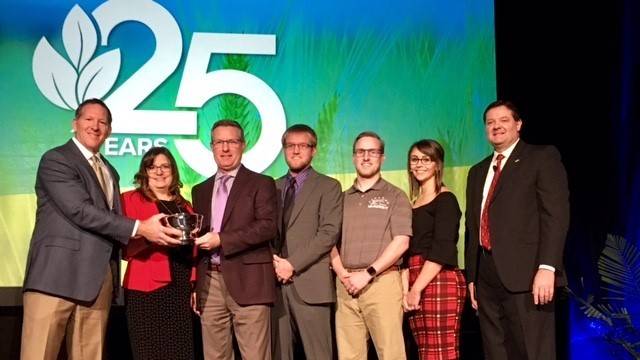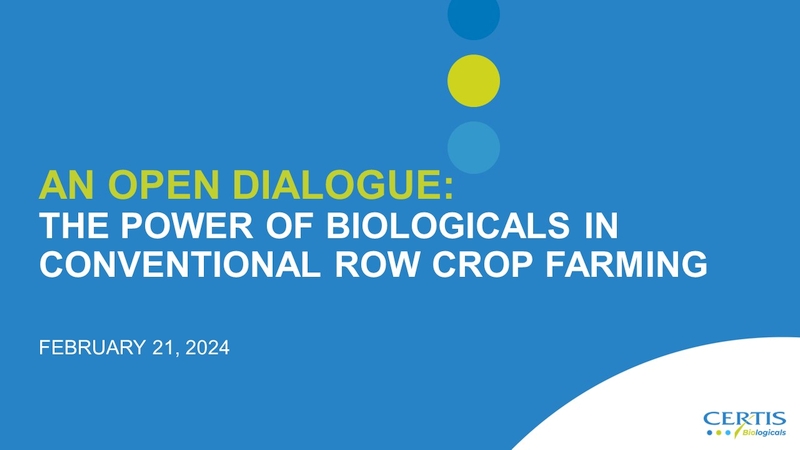Dicamba Update: Asmus Agronomists Talk Dicamba, Enlist E3 Swing Potential

Mark Helt, National Sales Manager for Monsanto, and ARA President and CEO Daren Coppock (far right), present Amy and Harlan Asmus with the 2017 Retailer of the Year Award. They accepted the award along with their sons Garrett and Holden and daughter-in-law, Billie, November 29 during the ARA Conference and Expo in Phoenix.
Asmus Farm Supply (ranked No. 61 on the CropLife 100), headquartered in Rake, IA, a stone’s throw from the southern border of Minnesota, is perhaps the perfect case study in the ag retailer’s role in stewarding successful dicamba applications.
For one, AFS does not offer much, if any, custom application work on the crop protection products it sells farmers. Secondly, operating across a three-state region (IA, MN, and NE) gives the sales agronomists and location managers at AFS exposure to three different state application labels and regulatory environments, a situation that gives the group a rather unique and geographically-varied view of the chemical in real-world situations.
AFS co-principal Amy Asmus, a CCA herself, gave a fantastic interview to CropLife’s Jackie Pucci last year on the operation’s experience with Enlist and Roundup Ready 2 Xtend cropping systems. You can check those Q&As, broken into two-parts, here (Part 1), and here (Part 2).

The three Asmus Farm Supply outlets that participated in this feature are pictured on the map above. Click to enlarge.
For this year, Amy convened a panel of three of AFS’ sale agronomists and location managers to give us an update on what the group is seeing and hearing going into the 2019 spray season. Brent Baddeley is a sales agronomist and location manager for AFS in the Estherville, IA, outlet, while Kevin Adolph fills the same role up in Fulda, MN, and sales agronomist Jason Christensen is stationed down in Rake, IA, in the same offices as Asmus.
Brent Baddeley, Estherville, IA
According to Baddeley, last year’s dicamba-tolerant soybean acreage in his area stayed “more or less steady” in 2018 and he expects a slight uptick in those acres heading into 2019. “What was put on early, pre-emerge, worked very well (last year),” Baddeley tells CropLife. “My branch only had one complaint, so I’m optimistic that this year, if we continue to do things right, we’ll see even better results.”
One reason Baddeley sees for the decrease in official dicamba drift complaints last season was a change in the applicator training put on by the manufacturers, specifically in how they were telling applicators to put on the herbicide.

Brent Baddeley, sales agronomist and location manager, Estherville, IA.
“That first year the growers were told to apply it later, and that was based more on weed height than a cutoff date at the time,” he explains. “And it was preached to them that there was little, or no, residual with this product. I think a lot of them learned from the School of Hard Knocks (that year) and this past year we focused on getting it out there earlier.”
When asked his number one recommendation he’s giving growers that intend to plant and spray the dicamba cropping system in 2019, Baddeley says it’s a mix of “use it pre-plant, pre-emerge, and I still like to have built in backup with some residual in there, say something like FlexStar GT or even another pass of dicamba.”
Asked what technologies he’s witnessed growers adopt in response to the dicamba drift situation last year, Baddeley says 2018’s relative success was a product of more awareness around what happens when you put dicamba on through non-label recommended nozzles, versus growers investing in things like hooded sprayers or other application technologies.
“What I’m seeing here is people using the right nozzles and just following all of the label recommendations by the manufacturers,” he says. “And they’re more closely following the recommendations on additives that can go in the tank that are drift retardants. And I’ve got a couple guys that run the (Raven) AccuBooms and they say that product has helped them very much.”
Jason Christensen, Rake, IA
Sales agronomist Jason Christensen has been in his current role with AFS for 9 years now, helping his mix of Minnesota and Iowa farmers adopt the right crop protection products for fields, among other responsibilities. Anytime you talk with Christensen about dicamba, then, you’re likely to get both sides of the coin: what he’s seeing with his Minnesota farmers, and what he’s seeing with his Iowa farmers.

Jason Christensen, sales agronomist, Rake, IA.
“Minnesota customers application acreage I would say was down from the year before, and I think that was mostly due to the fact that Minnesota set more of a cut-off date versus how Iowa regulates applications by vegetation stage of the crop,” he explains. “I would say that on the application front, bean (planting) intentions are higher in Xtend beans this year, but there’s still guys out here that are maybe a little bit scared of the chemistry so they’re sticking with the Flexstar GT programs.”
Liberty-tolerant bean acres are also up in his territory, a fact that Christensen says has less to do with the expected super-late planting window much of the Upper Corn Belt is likely to see with this years long, very wet late-winter/early spring season. “The acres will still have to get planted, and I don’t see those guys going away from a dicamba product to a RoundupReady 2 Xtend campaign based on the shortened spring.”
Like his cohort over in Estherville, Christensen credits earlier spray windows with 2018’s relatively low amount of drift complaints in the areas. “They sprayed it so early, beans were either just emerging or barely out of the ground yet, the guys that have gone earlier have had a lot of success,” he explains. “And I think that’s why Minnesota set that (cut-off) date, they looked at the drift complaints and what date they occurred and saw the percentage of drift, or off-target movement, went up the later you got into the season.”
Visual symptoms of dicamba drift also slowed down in his area in 2018, according to Christensen.
“That first year it was very easy to see a (seed) sign that says dicamba beans at the edge of the field and typically within half a mile of those fields you could easily find a field of cupped beans from potential drift or off target movement, and last year we just didn’t see those fields with the leaves all cupped like that, it was nothing like the year before,” he remembers.
Additionally, Christensen sees a possibility of a mass product switch among his growers away from the Xtend system to the coming Corteva Agriscience Enlist E3 soybean traits that tolerate glyphosate, glufosinate and 2,4-D herbicides.
“Dicamba works well and it’s a really good tool but there’s also an inherent amount of risk for the applicator, which in our case is the farmer more often than not, that comes with that type of product,” he explains. “The temperature inversions, the volatility…I’d say that if growers see that the E3/2-4,D beans are yielding it’s going to be a big deal because of the reported zero volatility that product offers. We’re already having to put residual products out with the dicamba anyways, and if its less risk (with that new system) it’s really a non-brainer for them.”
Where growers are more likely to stick with dicamba going forward is in situations where they are battling glyphosate-resistant giant ragweed, according to Christensen.
“I would say that dicamba is probably a little bit better on giant ragweed than 2-4,D, because for a long time people went out and killed giant ragweed with the 2,4-D on the fence rows, so maybe there is some selective resistance there, I don’t know.”
Kevin Adolph, Fulda, MN
Also in the dual-role of location manager/sales agronomist for AFS is Kevin Adolph. And like his colleague Christensen, Adolph also serves growers on each side of the Minnesota-Iowa border.
“We’re seeing a major swing from dicamba to Liberty on the Minnesota side, and on the Iowa side guys are sticking with dicamba so acreage should potentially be up from last year, and the year before that acreage was up,” Adolph remembers. “Just like Jason said, in Iowa last year they could spray a week longer, so there was a lot that got sprayed right up against the cutoff deadline and it turned out great for those growers. We had zero complaints in 2018 and I think that was due to guys recognizing what went wrong in 2017 and adjusting. Plus, the weather was just a whole lot better (for spraying) this past year.”

Kevin Adolph, sales agronomist and location manager, Fulda, MN.
The cutoff date in Minnesota is a limiting factor for Adolph’s growers, no doubt about it.
“In Minnesota we just can’t get it (dicamba) on in time, and the guys that do decide to go with it this year will have to get in there really early and then come back in with a post (application) later on, too,” he says. “I think the acreage (in Minnesota) will be down again this year, in most cases replaced by Liberty.”
Adolph is also interested to see how things develop with Corteva’s E3 Enlist system.
“I agree with Jason, if that system works and the yields are there it’s going to be the end of dicamba on the later post (application) stuff, that’s for sure,” he says.
As for how last year’s preseason applicator and farmer training resulted in fewer drift complaints in 2018, Adolph thinks that’s a direct response to applicators having more experience with the chemical (being applied in a later spray window) the second time around.
“The next year guys could relate to it (the training) better and pick up on the thing’s they did last year that turned out not so good,” he says. “Also the nozzles and tips that are label-recommended, that was a plus because I think in year one guys didn’t like the coverage they were getting with those new nozzles and some might’ve switched back to the old nozzles, and now our guys are sticking with the label recommended ones because they’ve gone through that little bit of trial-and-error now.”






